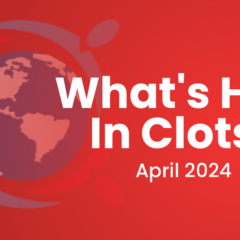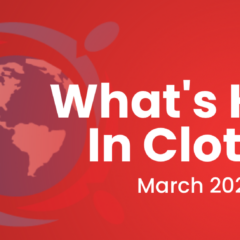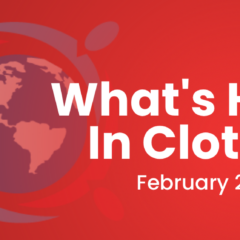Last updated on
Clot Chronicles: Trial Takeaways from AHA 2020
Hello, this is Christian Ruff, Director of General Cardiology at Brigham and Hospital and Harvard Medical School. It’s my pleasure to bring to you today Clot Chronicles and a recap of a very exciting 2020 American Heart Association conference. As you all know, it was done virtually this year, but that did not stop the sharing of some exciting science that’s been generated over the past year.
For our NATF listeners, I’d like to start off with a very important study, the RIVER study, which evaluated rivaroxaban with valvular heart disease and atrial fibrillation (Afib). This trial looked at those patients with Afib or flutter and a bioprosthetic mitral valve. We know there’s been a lot of controversy about whether non-vitamin-K oral anticoagulants (NOACs, also known as direct oral anticoagulants or DOACs) are, in fact, indicated for patients with valvular heart disease in general, but specifically in those who’ve had a valve replacement.
We know from the NOAC trials that there were lots of patients with valvular heart disease, and the NOACs look just as good in those patients – but a lingering question has been regarding those who’ve had a valve replacement, in particular. We know that there’s a contraindication to NOACs in patients with mechanical heart valves.
There were two trials, the ENGAGE AF-TIMI 48 and ARISTOTLE trial, that did include patients with bioprosthetic valves in the NOAC versus warfarin trials, but they were relatively underrepresented – a total of 200 patients. And this trial, the RIVER trial, looked at over 1,000 patients, mostly at sites in Brazil, in patients who had Afib or flutter and bioprosthetic mitral valve.
Importantly this study, first of all, was much bigger than our current representation of bioprosthetic valve patients and allowed patients who had early implantation of a valve; you could enroll a patient as early as 48 hours after implantation. And, in fact, about 20% of patients actually were within that 3-month window from mitral valve replacement. In the traditional NOAC trials, you weren’t allowed to enroll patients until 3 months after bioprosthetic valve implantation.
The results were very reassuring that rivaroxaban was certainly noninferior—robustly noninferior—to warfarin in these patients. And if you actually look at the endpoint we care most about, which is stroke, that that was actually significantly less with rivaroxaban compared to warfarin. And there was a nonsignificant decrease in major bleeding of 50%.
So, I think this really puts the issue to rest that NOACs—and in this case, rivaroxaban—are an excellent alternative to warfarin in patients with bioprosthetic valves even early after bioprosthetic valve implantation. In fact, rivaroxaban actually looked the best in patients who had early implantation of a bioprosthetic valve. And so, I think now the only contraindication to NOACs is those patients with mechanical valve replacement.
Staying in Afib, there’s a lot of interest in whether we could prevent Afib from occurring in the first place. There had been several trials of vitamin D and omega-3 fatty acids for secondary prevention, and there’ve been a lot of epidemiologic data that patients with low levels of vitamin D and omega-3 were at an increased risk of developing Afib.
And so the question, therefore, is if we give vitamin D or omega-3 supplementation—fish oil—would we decrease the incidence of Afib? And in part of a large program called the VITAL program, they looked specifically in VITAL-Rhythm at Afib. Unfortunately, supplementation with vitamin D and fish oil did not reduce the incidence of Afib, so it does not appear that prophylactically giving patients vitamin D or omega-3 will reduce their risk of developing Afib. But an important study that I think informs our long-term practice.
Now staying with fish oil, there was a lot of controversy at the American Heart Association. There were two studies with fish oil – one the STRENGTH trial, which was looking at patients who had dyslipidemia and a high risk for cardiovascular disease. And another trial called OMEMI, which looked at patients who were elderly who had a myocardial infarction (MI) and looking at whether fish oil supplementation decreased the risk of cardiovascular events. Both of these trials ended up being neutral trials – it did not appear that adding fish oil to the regimen decreased the risk of major adverse cardiovascular events.
There’s a lot of controversy about these studies because the findings are in contrast to the REDUCE-IT trial, which showed that giving fish oil in patients with dyslipidemia and high triglycerides actually reduced the risk of cardiovascular events independent of the triglyceride-lowering effect. Now what are some of the reasons why we might have discordant events, particularly with STRENGTH and REDUCE-IT? One of the reasons is that the preparation of fish oil was different.
In the REDUCE-IT trial, it was a pure EPA, and we know that fish oil can be made up of EPA and DHA. So in REDUCE-IT, it was a pure high-dose EPA. And in the STRENGTH trial, it was a mixed EPA/DHA regimen or a carboxylic acid formulation that was thought to be much more bioavailable. So, it’s possible that it just matters what type of fish oil you have and that giving a highly purified EPA is different than giving a mixed fish oil.
Another aspect that came in the discussion of these trials is that it may also matter what the comparator is. In the REDUCE-IT trial, there was a mineral oil used; that can actually have some deleterious lipid effects. And in these trials, they actually used a corn oil, which is neutral from a cardiovascular perspective. So it could be a combination of both the fish oil preparation and the comparison that may have impacted the differences in those trials. The results certainly has thrown a little bit of the benefit of fish oil in these patients into question and I think we need more information.
And then moving on to the management of Afib, there were two important studies, the EARLY-AF study and the STOP-AF study. These studies addressed whether upfront ablation for Afib is preferable to a trial of antiarrhythmic therapy. We know, traditionally, most patients who have paroxysmal Afib will get a trial of at least one (and sometimes more) antiarrhythmic drugs before they will transition to ablation. We’ve sort of begun to think that maybe upfront ablation for Afib is not only more likely to be durable and successful, but may be better at preventing the burden of Afib.
In these two trials of cryoablation, patients with Afib showed just that, that if you did upfront ablation and no trial of antiarrhythmic therapy, that you reduced the recurrence of Afib. Now whether this translates into cardiovascular benefit to these patients—decreased adverse cardiovascular events or stroke, etc.—remains to be seen and needs larger outcome studies.
And I think just to end on one of the big blockbuster trials at the AHA that kind of affects everybody in medicine and in cardiology, of course, was the polypill (the TIPS-3 trial). And again, a very interesting study that looked at a fixed-dose polypill—a combination of three antihypertensive regimens plus a statin with a second randomization to low-dose aspirin or not—and whether that was beneficial. This study was done internationally but mainly in south and southeast Asia.
And it showed that the combination of a polypill plus aspirin decreased a broad array of cardiovascular events by about 30%. So, certainly a very provocative study and maybe this kind of simple approach may have huge societal implications where we could reduce the risk of MI and stroke in a very easy-to-give single pill that may aid with compliance. And interestingly, this approach may have benefits in both under-resourced and high-resourced countries, so I don’t think that we can just translate these results purely into resourced-challenged countries.
So again, an incredibly exciting AHA with lots of wonderful science. Of course, it was done in the era of COVID, and there were also lots of terrific registries that were presented at the American Heart Association that confirmed a lot of the emerging themes; patients with cardiovascular comorbidities are at higher risk of complications of being admitted to the hospital, of being admitted to the intensive care unit, and of having complications that lead to morbidity and mortality. I think for NATF listeners, thrombosis is an important morbid—and often fatal event—in these patients. So clearly, there’s something about having COVID infection that increases the risk of both arterial and venous thrombosis, and there’s lots of exciting studies being done regarding whether anticoagulation improves outcomes in COVID-infected patients.
So thank you, again. It was a pleasure updating you on some of the exciting science at the American Heart Association 2020, and I look forward to our next update.



